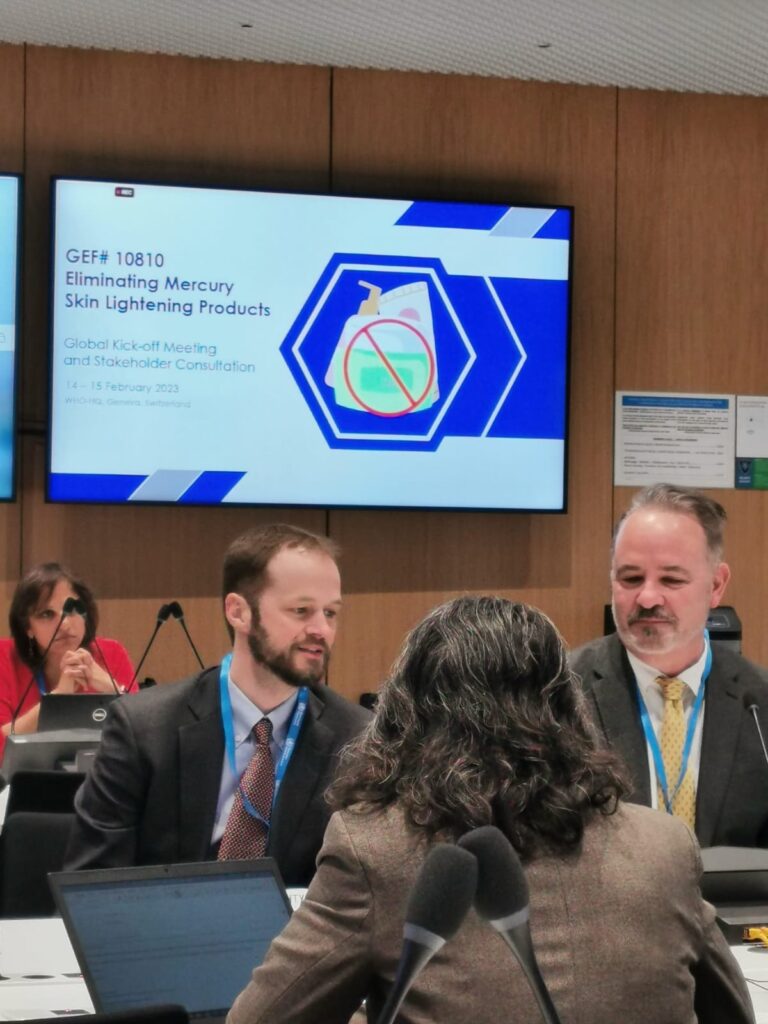Eliminating Mercury Skin Lightening Products
Inorganic mercury is a common ingredient found in skin lightening products (SLPs). The Minamata Convention on Mercury requires that Parties to the Convention phase out the manufacture, import, and export of certain mercury added products including cosmetics with mercury content above 1ppm.
Project Objective
The Global Environment Facility (GEF) funded project Eliminating Mercury Skin Lightening Products aims to reduce the risk of exposure to mercury-added skin lightening products in both humans and the environment. The goal is to eliminate mercury-containing skin lightening products through initiatives that address the main needs for the management of SLPs, which include (but are not limited to) national capacity building on legislation, enforcement, laboratory capabilities, and awareness raising strategies.
Collaborating with the World Health Organization
BRI is collaborating with the World Health Organization (WHO) for the co-execution of the project which, is implemented by the United Nations Environment Programme (UNEP). Project beneficiary countries include Gabon, Jamaica, and Sri Lanka. UNEP’s Global Mercury Partnership will provide technical assistance.
For details and updates on project activities, please visit the UNEP Global Mercury Partnership page here.
Eliminating Mercury Skin Lightening Products Global Kickoff Meeting
The Eliminating Mercury Skin Lightening Products Global Kickoff Meeting occurred in Geneva, Switzerland, on February 14th and 15th. The meeting launched the three-year project that will bring the countries together to align their policies on the cosmetic sector with best practices, creating an enabling environment to phase out mercury and attempting to shift broader cultural norms on skin complexion through engaging organizations, healthcare professionals and influencers working in the field.
“Mercury is a hidden and toxic ingredient in the skin lightening creams that many people are using daily, often without an understanding of just how dangerous this is,” GEF CEO and Chairperson Carlos Manuel Rodriguez said. “This initiative is significant as it focuses not only on substitutions for harmful ingredients but on awareness building that can help change behaviors that are damaging to individual health as well as the planet.”
The kickoff meeting has been highlighted worldwide, with the meeting press release featured in 94 articles in 90 media outlets across 27 countries (as noted in the map below) and 6 languages.
See the full press list here.
Inception Meeting Report for Eliminating Mercury Skin Lightening Products

See below for photos of BRI staff taking part in panel discussions during the meeting.

Gabon
In Gabon, inventory assessments conducted under Minamata Initial Assessments (MIAs) estimated that 4,385 kg of mercury per year were released due to cosmetics such as SLPs.
The Government of Gabon has implemented several measures to address the issue of SLPs such as the development of a national strategy in 2017 by the Directorate of Medicines and Pharmacies (DMP) in connection with the General Health Inspectorate to control the sale and distribution of SLPs nationally.

Jamaica
In Jamaica, research has shown that SLPs have been promoted through advertisements, marketing strategies and popular culture influencers, aimed particularly at African-Jamaican women. In 2004, it was reported that approximately 10 -15% of patients seen by dermatologists locally had been using SLPs.
There are several initiatives in Jamaica to address SLPs, but the development and implementation of regulations have been problematic. This project aims to address the legislative, regulatory, and institutional needs to adequately manage SLPs in Jamaica as well as conduct public awareness activities.

Sri Lanka
Sri Lanka has 23 official local cosmetics and pharmaceutical manufacturing industries involved in the production of cosmetics and soaps. Research conducted by the Centre for Environmental Justice (CEJ) found high levels of mercury in many skin-whitening cream brands available in the local market in Sri Lanka. Of those assessed, 2 out of 5 locally manufactured skin whitening creams had concentrations higher than the permissible level.
The importation of SLPs are difficult to monitor as SLPs are grouped with a wide range of other related products under the same Harmonised System (HS) Code. A lack of labeling standards also exists.
Other Mercury Related Resources and Publications
- Caribbean Mercury Monitoring Network Report
- Mercury in the Global Environment
- Local, Regional, and Global Biomonitoring: Understanding Mercury Exposure through Monitoring At-risk Species
- Global Mercury Monitoring in Biota (8-page summary)
- Phasing Out/Phasing Down Mercury-added Products: What to Know About Consumer and Commercial Products Outlined in the Minamata Convention
Photo Credits: Header photo © Shutterstock





